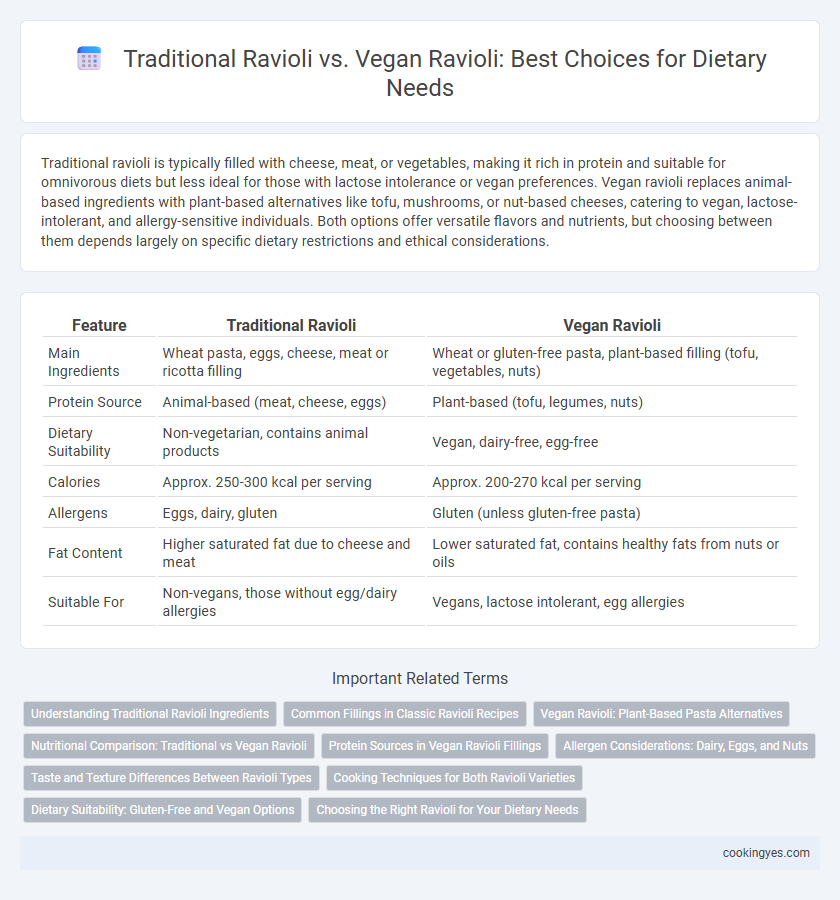Traditional ravioli is typically filled with cheese, meat, or vegetables, making it rich in protein and suitable for omnivorous diets but less ideal for those with lactose intolerance or vegan preferences. Vegan ravioli replaces animal-based ingredients with plant-based alternatives like tofu, mushrooms, or nut-based cheeses, catering to vegan, lactose-intolerant, and allergy-sensitive individuals. Both options offer versatile flavors and nutrients, but choosing between them depends largely on specific dietary restrictions and ethical considerations.
Table of Comparison
| Feature | Traditional Ravioli | Vegan Ravioli |
|---|---|---|
| Main Ingredients | Wheat pasta, eggs, cheese, meat or ricotta filling | Wheat or gluten-free pasta, plant-based filling (tofu, vegetables, nuts) |
| Protein Source | Animal-based (meat, cheese, eggs) | Plant-based (tofu, legumes, nuts) |
| Dietary Suitability | Non-vegetarian, contains animal products | Vegan, dairy-free, egg-free |
| Calories | Approx. 250-300 kcal per serving | Approx. 200-270 kcal per serving |
| Allergens | Eggs, dairy, gluten | Gluten (unless gluten-free pasta) |
| Fat Content | Higher saturated fat due to cheese and meat | Lower saturated fat, contains healthy fats from nuts or oils |
| Suitable For | Non-vegans, those without egg/dairy allergies | Vegans, lactose intolerant, egg allergies |
Understanding Traditional Ravioli Ingredients
Traditional ravioli ingredients typically include wheat flour, eggs, ricotta cheese, and various meats or vegetables, providing a rich source of protein and essential nutrients. This combination offers a gluten and lactose presence, which may not be suitable for those with celiac disease or lactose intolerance. Understanding these components helps in addressing specific dietary needs and making informed choices between traditional and vegan ravioli options.
Common Fillings in Classic Ravioli Recipes
Traditional ravioli commonly feature fillings such as ricotta cheese, spinach, ground meat, and Parmesan, providing a rich source of protein and calcium but may pose challenges for lactose-intolerant or vegetarian individuals. Vegan ravioli fillings often include plant-based ingredients like tofu, mushrooms, butternut squash, and cashews, catering to dairy-free and cruelty-free dietary preferences while ensuring nutrient diversity. Selecting between traditional and vegan ravioli depends on dietary restrictions related to allergens, ethical choices, and nutritional goals.
Vegan Ravioli: Plant-Based Pasta Alternatives
Vegan ravioli offers a plant-based pasta alternative made from ingredients like spinach, beetroot, or chickpea flour, catering to dietary needs that avoid animal products. Traditional ravioli typically contains eggs and dairy in the dough or filling, which may not suit vegans or those with lactose intolerance. Opting for vegan ravioli provides a nutrient-rich option high in fiber and protein while supporting cruelty-free and environmentally sustainable eating habits.
Nutritional Comparison: Traditional vs Vegan Ravioli
Traditional ravioli typically contains high levels of protein and fat from ingredients like eggs and cheese, offering essential amino acids and calcium. Vegan ravioli uses plant-based fillings such as spinach, mushrooms, or tofu, which are lower in saturated fat and cholesterol while providing fiber, vitamins, and antioxidants. Comparing nutritional values reveals vegan ravioli often contains fewer calories and saturated fats, making it a heart-healthier option for those with dietary restrictions or preferences.
Protein Sources in Vegan Ravioli Fillings
Traditional ravioli typically contains protein from animal-based sources such as ricotta cheese, meat, or eggs, providing complete amino acid profiles. Vegan ravioli fillings rely on plant-based proteins like lentils, tofu, chickpeas, and nuts to meet dietary needs while ensuring adequate protein intake. These vegan protein sources offer fiber, essential amino acids, and lower saturated fat, catering to those with plant-based or lactose-free dietary preferences.
Allergen Considerations: Dairy, Eggs, and Nuts
Traditional ravioli often contain dairy and eggs, posing allergen risks for individuals with lactose intolerance or egg allergies. Vegan ravioli eliminates these allergens by using plant-based ingredients, making it suitable for those with dairy and egg sensitivities. Nut-based fillings in some vegan ravioli require allergen awareness for individuals with nut allergies.
Taste and Texture Differences Between Ravioli Types
Traditional ravioli feature a tender pasta exterior filled with rich, creamy cheeses and seasoned meats, offering a savory, indulgent taste and a smooth, melt-in-the-mouth texture. Vegan ravioli use plant-based fillings like mushrooms, tofu, or cashews, creating a lighter flavor profile with varied textures ranging from creamy to slightly firm, often enhanced by herbs and spices for depth. The contrast in fat content and moisture levels between dairy-based and plant-based fillings significantly influences the overall mouthfeel and flavor intensity in each ravioli type.
Cooking Techniques for Both Ravioli Varieties
Traditional ravioli requires boiling in salted water until al dente, typically 3 to 5 minutes, preserving the tender pasta and savory filling. Vegan ravioli, often made with gluten-free or alternative flours and plant-based fillings like mushrooms or tofu, may need gentler boiling or steaming to maintain texture and prevent breakage. Both variations benefit from careful handling and immediate serving to ensure optimal flavor and structural integrity while catering to diverse dietary preferences.
Dietary Suitability: Gluten-Free and Vegan Options
Traditional ravioli typically contains wheat-based pasta and egg, making it unsuitable for gluten-free and vegan diets. Vegan ravioli substitutes dairy and eggs with plant-based ingredients, offering a suitable option for those avoiding animal products. For gluten-free dietary needs, both traditional and vegan ravioli varieties are available with gluten-free pasta made from rice, corn, or other alternative flours.
Choosing the Right Ravioli for Your Dietary Needs
Traditional ravioli, often made with eggs and filled with cheese or meat, provides a rich source of protein and essential nutrients but may not suit those with lactose intolerance, egg allergies, or vegetarian and vegan diets. Vegan ravioli substitutes dairy and eggs with plant-based ingredients such as tofu, spinach, mushrooms, or legumes, catering to those seeking lower cholesterol, vegan, or plant-based options without sacrificing taste. Selecting the right ravioli depends on individual dietary restrictions and nutritional goals, emphasizing ingredient awareness and label checking to ensure alignment with health needs.
Traditional Ravioli vs Vegan Ravioli for dietary needs Infographic

 cookingyes.com
cookingyes.com